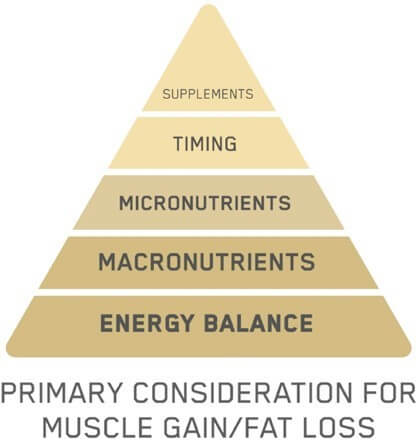ASSESSING NUTRITIONAL REQUIREMENTS
- Before setting nutritional recommendation, you need to assess the current nutritional and lifestyle practices of the client
- This will ensure that any recommendation or goals set are attainable for the client and maximise results
- This is a requirement before any nutritional recommendations can be made
- Important to remember that energy balance is the primary consideration for programming
CONSIDERATIONS WHEN ASSESSING ENERGY REQUIREMENTS
- Lifestyle (Energy Requirements)
- Training Status
- Body Composition
- Current Dietary Intake
- Individuals Goals
AIM OF NUTRITIONAL ASSESSMENT
- Determine Current Nutritional Intakes in individuals or Groups
- Forms the Basis for Nutritional Recommendations e.g. Surplus, Deficit, Nutritional Deficiencies etc.
- To Identify High Risk Groups with Respect to Nutritional Vulnerability
- To Make Recommendation to Rectify Shortcomings
Anthropometry
Biochemical and Lab methods
Clinical assessment
Diet Survey / Assessment
Ecological studies
Functional assessment
DIETARY RECALL
- Recall all foods and drinks consumed in 24 hours prior to interview
- Regional and ethnicity specific preparations and methods
- Structured, without probing questions
- Food amounts converted into nutrient intakes using food composition tables
DIET HISTORY
- Structured Interview Method
- Traditionally Includes 3-Day Food Record
- ‘Cross Check’ to Clarify Information About Usual Intake In Past 3, 6 or 12 Months
- Clinical Practice
- Meal Timings, Food Preparation
FOOD DIARY
- Require Client to Weigh All Foods and Beverages for a Given Length of Time
- Precise and High Validity
- Reference Method in Validation Studies
- Tendency of Clients to Report Close to what is Socially Desirable
- High Respondent Burden
- May Influence Food Behaviour
- Difficulty in Measuring Portion Sizes
- New Technologies
NUTRITION PROGRAMMING
- Client Goals
- Calculated BMR
- Lifestyle Factors
- Time Available for your Programming
- Client Health Status
- Client Preferences
MACRONUTRIENT TARGET SETTING
- Once energy requirements are covered, macronutrients such as protein should be considered
- Timing meals around training may be beneficial
- For example, a meal high in carbohydrate in the lead up to a training session
- It is fruitless to focus on supplements and timing of meals when energy balance is not aligned with clients goals
MACRONUTRIENT TARGET SETTING FOR FAT LOSS
- Looking at macronutrients specifically, there is a hierarchy when fat loss is the goal as per illustration
- Fat and carbohydrates are relatively interchangeable
NUTRITION LABELS ON PACK
- Nutrition labels are often displayed as a panel or grid on the back or side of packaging
- This type of label includes information on energy as kilojoules or kilocalories, fat, saturate or unsaturated fat, carbohydrate, sugars, protein and salt
- It may also provide additional information on certain nutrients, such as fibre
- All nutrition information is provided per 100 grams and sometimes per portion
- When comparing labels always use per 100g values
- Total Fat
- High: more than 5g of fat per 100g
- Low: 3g of fat or less per 100g
- Saturated Fat
- High: more than 5g of saturated fat per 100g
- Low: 1.5g of saturated fat or less per 100g
- Sugars
- High: more than 22.5g of total sugars per 100g
- Low: 5g of total sugars or less per 100g
- Salt
- High: more than 1.5g of salt per 100g (or 6g sodium)
- Low: 0.3g of salt or less per 100g (or 1g sodium)
Alternatives
- Aggressive Dieting Methods
- Intermittent Fasting
- Slow Down Eating, Minimise Distraction
- Simple Swaps
- Weight Loss Improves Almost All Obesity Related Co-morbidity and Metabolic Markers Regardless of the Macronutrient Composition of the diet. Individuals will have Macronutrient or Dieting Preferences
MOST COMMON UTILISED DIETS
- Low Fat
- Low Carbohydrate
- Mediterranean Diet
- Commercial Slimming Programs
- Meal Replacements
- Intermittent Fasting
Summary
- Assess Current Diet Practices
- Calculate Current Energy Intake
- Diet Recall
- Diet History
- Food Frequency Questionnaire
- Determine the Most Achievable Method to Maintain Recommended Intakes
- Lifestyle
- Food Preference
- Attitude
- Create an Open, Honest Professional Environment





